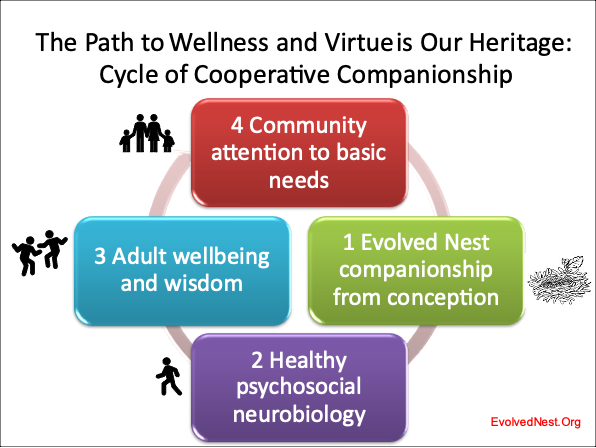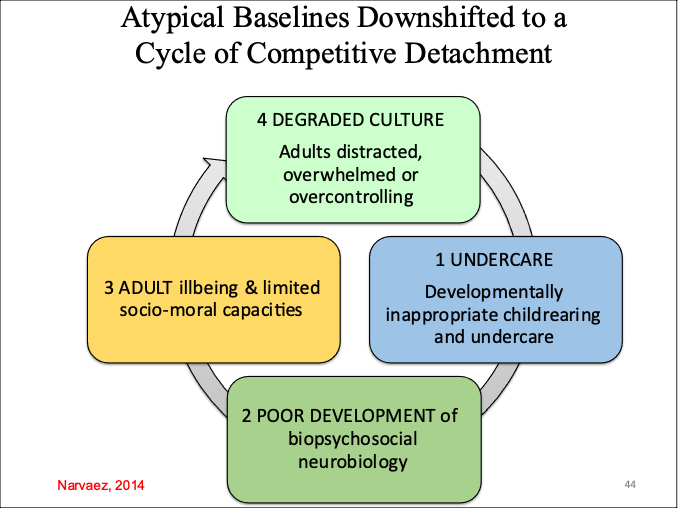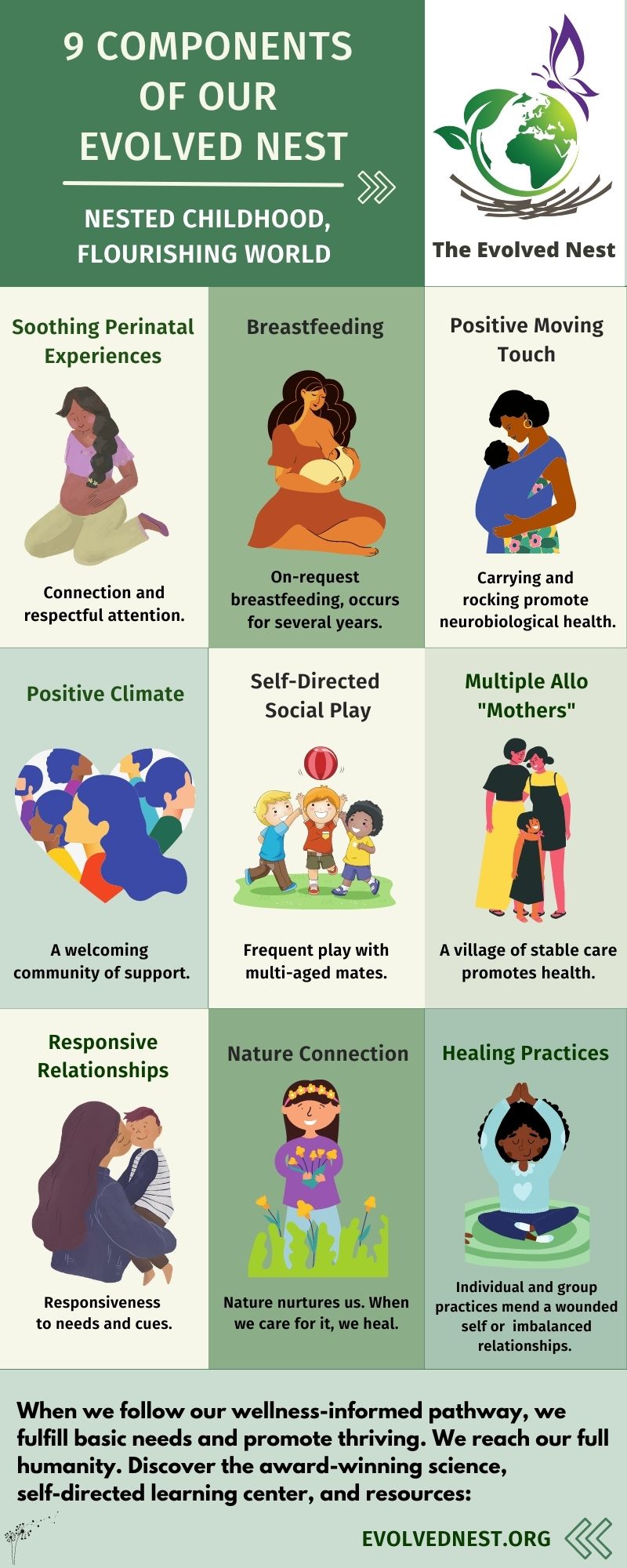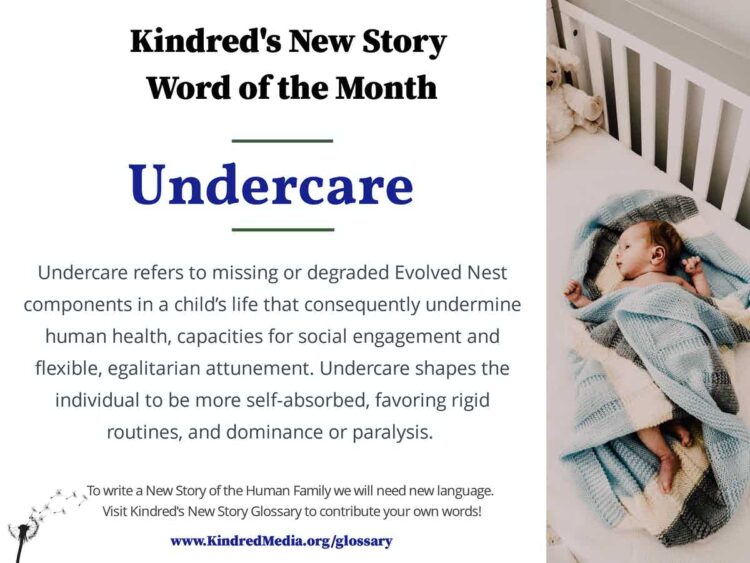To not receive the EDN [evolved developmental niche] in early life can be perceived as an injustice to a child, with serious ramifications for the child’s future. If brain and body system thresholds are established sub-optimally in early years—not by trauma, but simply by not providing care that children evolved to need, then children may not reach their full potential but remain cognitively and socially underdeveloped. - Darcia Narvaez, PhD
Visit the www.EvolvedNest.org for more on the science of our evolutionary pathway to wellbeing.
State of USA Today. Child mental and physical well being have been on the decline for over 50 years in the USA, the wealthiest nation on earth. People under the age of 65 (today) score at or near the bottom on multiple health indicators compared to citizens in 16 other advanced nations (National Research Council, 2013). The USA has heightening epidemics of depression, anxiety, psychosocial and health problems at all ages (UNICEF, 2007; OECD, 2009). Because humans are holistic creatures, attachment, sociality and moral capacities have also been declining (e.g., empathy, moral reasoning) (Konrath et al. 2011, 2014). Avoidant attachment has been increasing along with narcissism, both of which undermine social and citizenship capacities (Twenge & Campbell, 2009). Sociopathy has become a cultural phenomenon (Derber, 2013).
Early Life Stress. Although there are likely multiple causes, we can surely point to one basic cause with converging evidence from across the human sciences. Early life toxic stress (Shonkoff et al., 2012; Lanius et al., 2010; van der Kolk, 2014). Recent research is tempering views that deficits from poor early care can be easily outgrown (Karr-Morse & Wiley, 2012; Lupien et al., 2009; Schore, 2019; van der Kolk, 2014). In fact, an increasing amount of converging evidence across animal, human psychological, neurobiological and anthropological research demonstrates the later vulnerability of brain and body systems among those with poor early care (Felitti & Anda, 2005).
Human Flourishing. We don’t have to guess or conduct extensive studies of what leads to human flourishing. Evolution, in effect, has ‘done the experiments’ over millions of years, providing the baselines for child raising and human flourishing. Evolution has provided a wellness-informed pathway (Narvaez, 2014). See Figure 1. In contrast, we can conclude that the USA follows a trauma-inducing pathway. See Figure 2.


Evidence for Wellness in Our Ancestral Context. The genus homo has spent 99% of its existence—around six million years—in foraging bands (Fry, 2006). This indicates that our bodies and brains evolved and adapted to this ancestral context, called the environment of evolutionary adaptedness (Bowlby, 1969). Some human societies have been in existence for over 150,000 years, such as the San Bushmen (Suzman, 2017), whose germ line is shared with all existing humans (Henn et al., 2011). Like the Bushmen, most people who ever existed lived in hunter-gatherer communities. Anthropological studies often focus on societies that still live with many of the principles of nomadic foragers, providing insight into the 200,000 years of our existence as a species, homo sapiens sapiens (Lee & Daly, 2005).
Basic Needs. Comparative socioecology and ethology, through the tools of neuroscience, give us insights into millions of years of our genus’ existence as part of the mammalian line in existence for tens of millions of years (e.g., (McDonald, 1998; Suzuki & Hirata, 2012). We are animals, specifically social mammals, a line that emerged 20-40 million years ago, retaining many brain characteristics and basic needs of social mammals generally (Franklin & Mansuy, 2010; Panksepp, 1998; Spinka, Newberry & Bekoff, 2001). Our animal needs include nourishment and warmth but our social mammalian needs also include affectionate touch, play, extensive bonding, and community support (Carter & Porges, 2013; Champagne, 2014; Narvaez, Panksepp et al., 2013). Anthropological studies show us that humans grow best when we share intersubjectivity (“limbic resonance;” Lewis Amini & Lannon, 2001) with multiple adults, are immersed in communal rituals and stories, and when children apprentice in adult activities (Hewlett & Lamb, 2005; Hrdy, 2009; Sorenson, 1998; Weissner, 2014).
Basic needs are particularly important to meet in early life when the brain and body are under construction, including a fuller set of needs than those Maslow (1970) identified. Moreover, self-actualization is the primary foundation for growth, guiding the ongoing self-organization of each child as basic needs are or are not met (Tarsha & Narvaez, in press).
Healthy Child Development. Humans evolved to have the most helpless newborns and the longest maturational schedule of any animal. Although all social mammals are vulnerable to poor outcomes from poor nurturing, human children are particularly vulnerable. Children at full-term birth are born with only 25% of adult brain volume; the brain triples its size in the first couple of years with nurturing care, whereas brain size and function does not grow in size or complexity with neglect (Perry et al., 1995). Children resemble fetuses of other animals till around 18 months of postnatal age, meaning that they have much to grow and self-organize based on physio-social experience (Montagu, 1968).
Converging research demonstrates that we are biosocial: healthy bodies, brains and sociality are formed from early social experience provided by family and community (Garner et al., 2021; Sandi & Haller, 2015). Brain systems are influenced by early experience with caregivers, so the effects of early experience have longterm neurobiological consequences (Schore, 2019). For example, the right brain hemisphere is scheduled to develop rapidly in the first years of life with nurturing care. Undercare underdevelops the right hemisphere potentially causing later mental health problems.
Human child raising practices, rooted in social mammalian parenting over 30 million years old, evolved to accommodate the immaturity and lengthy maturational schedule of the young, community practices characteristic of over 99% of human genus existence and still apparent in Indigenous cultures resistant to globalization (Hewlett & Lamb, 2005).
The Evolved Nest. Every animal has an evolved nest for its young that forms part of an extra-genetic inheritance corresponding to the needs and maturational pace of offspring (Gottlieb, 1991; Oyama, Griffiths & Gray, 2001). Humanity’s evolved nest (aka, evolved developmental niche; EDN) in early life includes soothing perinatal experiences, extensive breastfeeding and positive touch, free play with multi-aged peers, nature immersion and connection, and routine healing practices. Human variations observed among hunter-gatherer societies also include positive social support for the mother-child dyad and multiple responsive adult caregivers (Hrdy, 2009). All these caregiving practices are correlated with health outcomes, but also with social and moral development (Narvaez, 2013, 2014, 2016; Narvaez, Gleason et al., 2013; Narvaez, Wang & Cheng, 2016; Narvaez, Wang et al., 2013; Narvaez, Wang et al., 2019; Narvaez, Woodbury et al., 2019).
Justice for Children, Societal Wellbeing. Our concern for young children and their caregivers is rooted in our concern for justice. To not receive the EDN in early life can be perceived as an injustice to a child, with serious ramifications for the child’s future. If brain and body system thresholds are established suboptimally in early years—not by trauma, but simply by not providing care that children evolved to need, then children may not reach their full potential but remain cognitively and socially underdeveloped. For example, children who do not receive supportive parenting early are less likely to behave prosocially (Kochanska, 2002). They are more likely to be self-centered and troublesome (Sroufe et al., 2005). While such children may sometimes function well enough as adults, holding down jobs and raising families, we are interested in caregiving environments that foster optimal development, our full human nature. This includes development of proactive concern for others—an orientation that includes a sense of social responsibility, global citizenship and prioritizing care for others, including the natural world.
Conclusion. Although being trauma-informed is helpful and we are appreciative of the increasing attention to ACES (Adverse Childhood Experiences) and their prevention, it’s not enough in an era of massive ecological destruction. In view of our species history, trauma prevention is not enough to raise a flourishing human being. We need the supportive structures of the EDN, our species developmental system, to grow children’s full capacities and to build thriving societies.

References
Lewis, T., Amini, F., & Lannon, R. (2000). A general theory of love. Vintage.
Bethell, C., Jones, J., Gombojav, N., Linkenbach, J., & Sege, R. (2019). Positive childhood experiences and adult mental and relational health in a statewide sample: Associations across adverse childhood experiences levels. JAMA Pediatrics, 173(11), e193007. DOI: 10.1001/jamapediatrics.2019.3007

Bowlby, J. (1969/1982). Attachment and loss: Vol. 1. Attachment (2nd ed.). New York: Basic Books (Original work published 1969).
Derber, C. (2013). Sociopathic society: A people’s sociology of the United States. Paradigm Press.
Felitti, V. J., & Anda, R. F. (2005). The Adverse Childhood Experiences (ACE) Study. Centers for Disease Control and Kaiser Permanente.
Garner, A., Yogman, M., Committee on Psychosocial Aspects of Child and Family Health, Section on Developmental and Behavioral Pediatrics, Council on Early Childhood. (2021). Preventing childhood toxic stress: Partnering with families and communities to promote relational health. Pediatrics, 148(2), e2021052582
Gottlieb, G. (2002). On the epigenetic evolution of species-specific perception: The developmental manifold concept. Cognitive Development, 17, 1287–1300.
Hewlett, B.S., & Lamb, M.E. (2005). Hunter-gatherer childhoods: evolutionary, developmental and cultural perspectives. Aldine.
Hrdy, S. (2009). Mothers and others: The evolutionary origins of mutual understanding. Belknap Press.
Karr-Morse, R., & Wiley, M.S. (2012). Scared sick: The role of childhood trauma in adult disease. Basic Books.
Kochanska, G. (2002). Mutually responsive orientation between mothers and their young children: A context for the early development of conscience. Current Directions in Psychological Science, 11, 191-195.
Konrath, S. H., Chopik, W., Hsing, C., & O’Brien, E. H. (2014). Changes in adult attachment styles in american college students over time: A meta-analysis. Personality and Social Psychology Review, 18(4), 326-348. doi: 10.1177/1088868314530516
Konrath, S. H., O’Brien, E. H., & Hsing, C. (2011). Changes in dispositional empathy in American college students over time: a meta-analysis. Personality and Social Psychology Review, 15, 180-198.
Lanius, R. A., Vermetten, E., & Pain, C. (2010). The impact of early life trauma on health and disease: The hidden epidemic. Cambridge University Press
Lupien, S.J., McEwen, B.S., Gunnar, M.R., & Heim, C. (2009). Effects of stress throughout the lifespan on the brain, behaviour and cognition, Nature Reviews Neuroscience, 10(6), 434-445.
Maslow, A. (1970). Motivation and personality, 2nd ed. Harper & Row.
McDonald, A.J. (1998). Cortical pathways to the mammalian amygdala. Progress in Neurobiology, 55, 257-332.
Montagu, A. (1968). Brains, genes, culture, immaturity, and gestation. In A. Montagu (Ed.), Culture: Man’s adaptive dimension (pp. 102-113). Oxford.
Narvaez, D. (2014). Neurobiology and the development of human morality: Evolution, culture and wisdom. Norton.
Narvaez, D. (2016). Embodied morality: Protectionism, engagement and imagination. Palgrave-Macmillan.
Narvaez, D. (Ed.) (2018). Basic needs, wellbeing and morality: Fulfilling human potential. Palgrave-MacMillan;
Narvaez, D., Gleason, T., Wang, L., Brooks, J., Lefever, J., Cheng, A., & Centers for the Prevention of Child Neglect (2013). The Evolved Development Niche: Longitudinal effects of caregiving practices on early childhood psychosocial development. Early Childhood Research Quarterly, 28 (4), 759–773. Doi: 10.1016/j.ecresq.2013.07.003
Narvaez, D., Panksepp, J., Schore, A., & Gleason, T. (Eds.) (2013). Evolution, early experience and human development: From research to practice and policy. Oxford University Press.
Narvaez, D., Wang, L, & Cheng, A. (2016). Evolved Developmental Niche History: Relation to adult psychopathology and morality. Applied Developmental Science, 20(4), 294-309. http://dx.doi.org/10.1080/10888691.2015.1128835;
Narvaez, D., Wang, L., Cheng, A., Gleason, T., Woodbury, R., Kurth, A., & Lefever, J.B. (2019). The importance of early life touch for psychosocial and moral development. Psicologia: Reflexão e Crítica, 32:16. doi.org/10.1186/s41155-019-0129-0;
Narvaez, D., Wang, L., Gleason, T., Cheng, A., Lefever, J., & Deng, L. (2013). The Evolved Developmental Niche and sociomoral outcomes in Chinese three-year-olds. European Journal of Developmental Psychology, 10(2), 106-127.
Narvaez, D., Woodbury, R., Gleason, T., Kurth, A., Cheng, A., Wang, L., Deng, L., Gutzwiller-Helfenfinger, E., Christen, M., & Näpflin, C. (2019). Evolved Development Niche provision: Moral socialization, social maladaptation and social thriving in three countries. Sage Open, 9(2). https://doi.org/10.1177/2158244019840123l
National Research Council (2013). U.S. Health in International Perspective: Shorter Lives, Poorer Health. National Academies Press.
Organization for Economic Cooperation and Development (2009). Doing better for children. Paris: OECD Publishing.; Organisation for Economic Cooperation and Development (2013), How’s Life? 2013: Measuring Well-being, OECD Publishing. http://dx.doi.org/10.1787/9789264201392-en
Oyama, S., Griffiths, P.E., & Gray, R.D. (2001). Cycles of contingency: Developmental systems and evolution. MIT Press.
Sandi, C., Haller, J. (2015). Stress and the social brain: behavioural effects and neurobiological mechanisms. Nature Reviews Neuroscience,16(5), 290-304. doi: 10.1038/nrn3918. PMID: 25891510.
Shonkoff, J.P., Garner, A.S. The Committee on Psychosocial Childhood, Adoption, and Dependent Care, and Section on Developmental and Behavioral Pediatrics, Dobbins, M.I., Earls, M.F., McGuinn, L., … & Wood, D.L. (2012). The lifelong effects of early childhood adversity and toxic stress. Pediatrics, 129, e232;
Spinka, M., Newberry, R. C., & Bekoff, M. (2001). Mammalian play: training for the unexpected. The Quarterly Review of Biology, 76(2), 141-168.
Sroufe, L.A., Egeland, B, Carlson, E.A., & Collins, W.A. (2008). The development of the person: The Minnesota study of risk and adaptation from birth to adulthood. Guilford.
Suzman, J. (2017). Affluence without abundance: The disappearing world of the Bushmen. Bloomsbury.
Suzuki, I.K., Hirata, T. (2012). Evolutionary conservation of neocortical neurogenetic program in the mammals and birds. Bioarchitecture, 2(4), 124–129.
Tarsha, M. & Narvaez, D. (in press). Community nestedness: Solving the roots of social problems. In R. Baikady, S.M. Sajid, J. Przeperski, F. Nadesan, M. R. Islam & G. Jianguo (Eds.), The Palgrave Handbook of Global Social Problems.
Twenge, J. & Campbell, R. (2009) The narcissism epidemic: Living in the age of entitlement. Free Press.
UNICEF (2007). Child poverty in perspective: An overview of child well-being in rich countries, a comprehensive assessment of the lives and well-being of children and adolescents in the economically advanced nations, Report Card 7. United Nations Children’s Fund Innocenti Research Centre;
Van der Kolk, B. (2014). The body keeps the score. New York: Penguin.
Wiessner, P. (2014). Embers of society: Firelight talk among the Ju/’hoansi Bushmen. Proceedings of the National Academy of Sciences of the United States of America, 111(39), 14027-14035.
Additional Papers Relevant to the Evolved Nest
Gleason, T., Tarsha, M.S., Narvaez, D., & Kurth, A. (2021). Opportunities for free play and young children’s autonomic regulation. Developmental Psychobiology, 63 (6), e22134. https://doi.org/10.1002/dev.22134
Narvaez, D., & Duckett, L. (2020). Ethics in early life care and lactation practice. Journal of Human Lactation. 36, 1-10. https://doi.org/10.1177/0890334419888454
Narvaez, D., Gleason, T., Tarsha, M., Woodbury, R., Cheng, A., Wang, L. (2021). Sociomoral temperament: A mediator between wellbeing and social outcomes in young children.Frontiers in Psychology, 12, 5111. DOI: 10.3389/fpsyg.2021.742199
Narvaez, D., Moore, D.S., Witherington, D.C., Vandiver, T.I., & Lickliter, R. (2022). Evolving evolutionary psychology. American Psychologist, 77(3), 424–438. https://doi.org/10.1037/amp0000849
Narvaez, D., & Witherington, D. (2018). Getting to baselines for human nature, development and wellbeing. Archives of Scientific Psychology, 6 (1), 205-213. DOI: 10.1037/arc0000053
Tarsha, M., & Narvaez, D. (2019). The Evolved Nest: A partnership system that fosters child wellbeing. International Journal of Partnership Studies, 6(3). Open access: doi.org/10.24926/ijps.v6i3.2244
Tarsha, M. S., & Narvaez, D. (2021). Effects of adverse childhood experience on physiological regulation are moderated by evolved developmental niche history. Anxiety, Stress & Coping. DOI: 10.1080/10615806.2021.1989419


Comments (0)